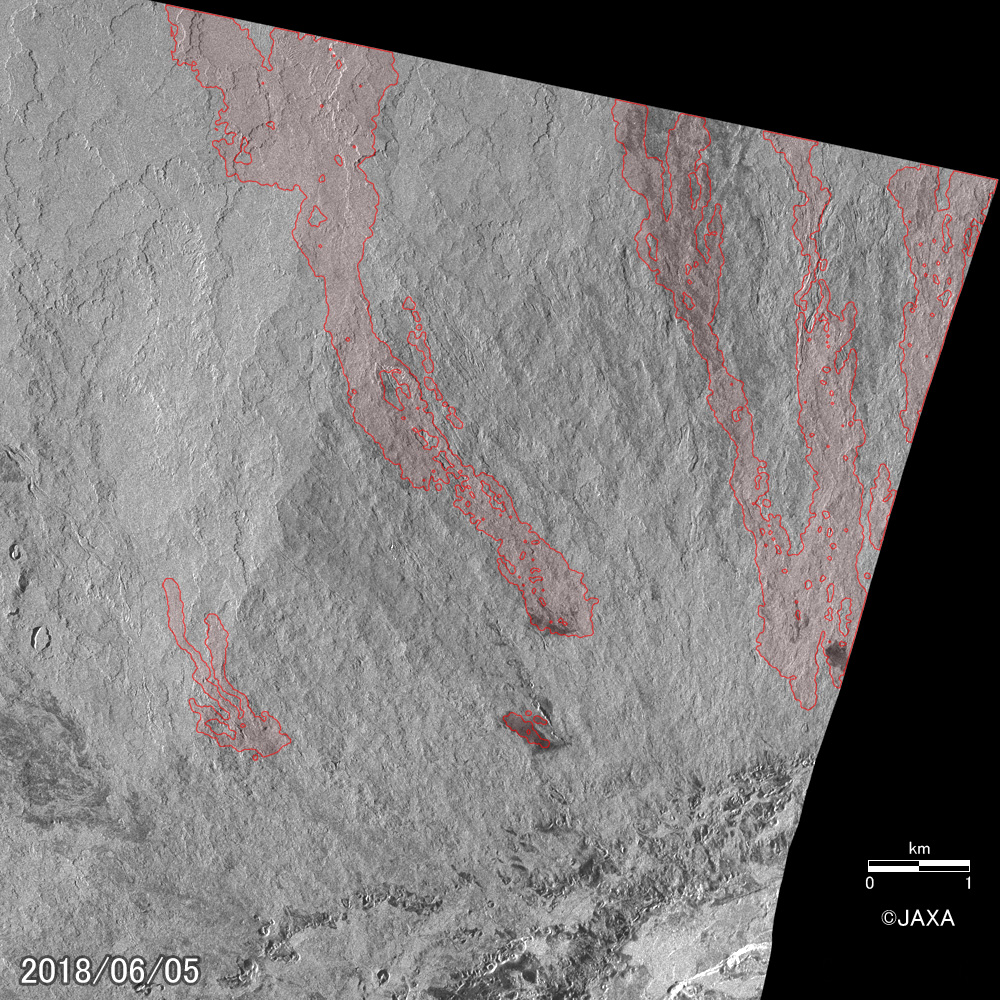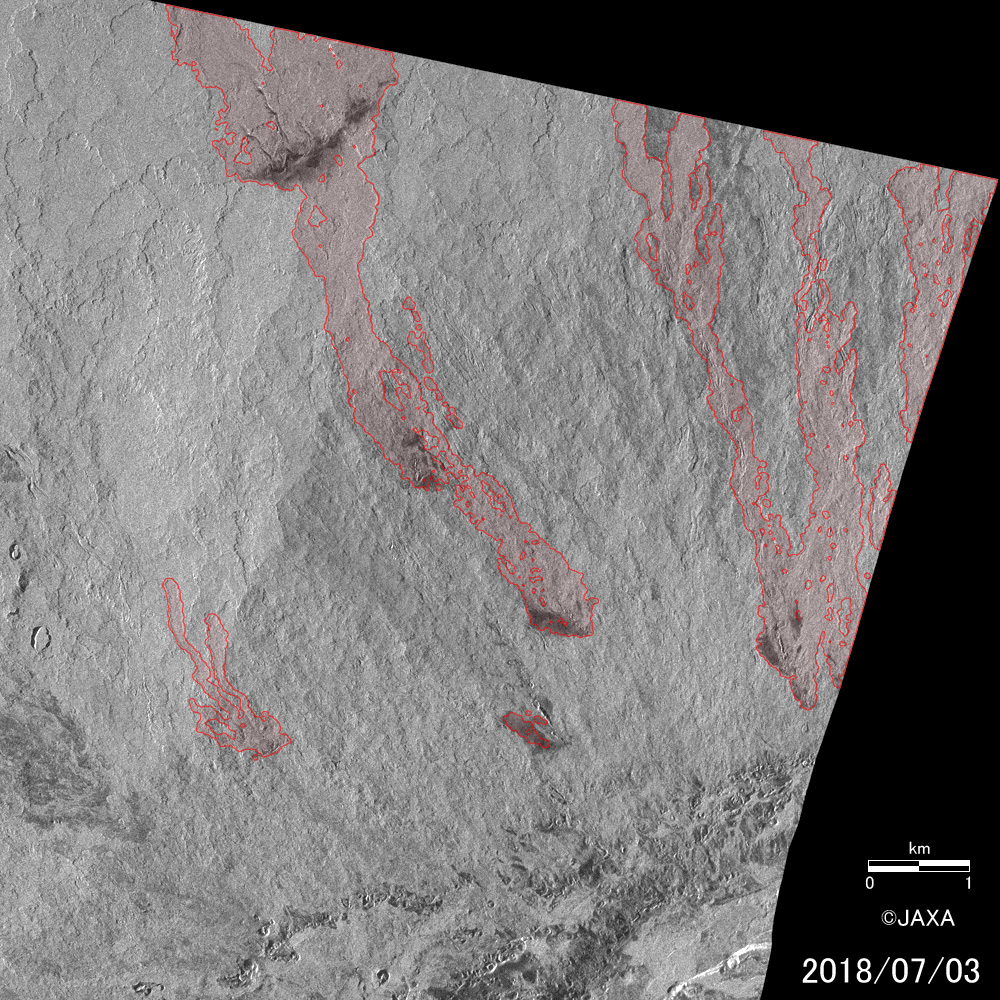
ALOS-2/PALSAR-2 Observation Result for Eruption of Mt. Sierra Negra in Galapagos
Posted: Jul. 13, 2018, 4:00 (UTC)
Overviews
- Mt. Sierra Negra in Isabela Island, Galapagos, has been erupting since June 26, 2018.
- JAXA has been observing the volcano by ALOS-2 (“DAICHI-2”) and captured the surface lowering in the crater and complex displacement in northwest side from the crater.
- ALOS-2 contributes to monitor volcanic activity regardless of clouds, volcanic plumes, and sun light.
| Observation time (UTC) | Path number | Orbit | Observation mode | Polarization | Observation direction | Beam number |
|
| ① | June 29, 2018 | 147 | Descending | ScanSAR | HH+HV | Right | W2 |
| ② | July 1, 2018 | 41 | Ascending | Stripmap 10m | HH+HV | Right | F2-7 |
| ③ | July 3, 2018 | 145 | Descending | Spotlight | HH | Right | - |
 Fig. 1: Topography around Mt. Sierra Negra and the observation areas by ALOS-2. The blue rectangle shows the area by Stripmap modeand the red one does that by Spotlight mode. The black one shows the area shown in Fig. 7.
Fig. 1: Topography around Mt. Sierra Negra and the observation areas by ALOS-2. The blue rectangle shows the area by Stripmap modeand the red one does that by Spotlight mode. The black one shows the area shown in Fig. 7.
 Fig. 2: An interferometric image of the ALOS-2 PALSAR-2 ScanSAR mode data acquired on June 29 and May 18, 2018.
Fig. 2: An interferometric image of the ALOS-2 PALSAR-2 ScanSAR mode data acquired on June 29 and May 18, 2018.
(Click to view enlarged image)
Figure 2 shows an interferogram using the ALOS-2 PALSAR-2 ScanSAR mode data acquired on June 29 and May 18, 2018. In this figure, subsidence inside the crater and complicate displacement in northwest side from the crater can be seen.
 Fig. 3: An interferometric image of the ALOS-2 PALSAR-2 Stripmap mode data acquired on July 1 and Jan 14, 2018.
Fig. 3: An interferometric image of the ALOS-2 PALSAR-2 Stripmap mode data acquired on July 1 and Jan 14, 2018.(Click to view enlarged image)
Figure 3 shows an interferogram using the ALOS-2 PALSAR-2 Stripmap (10 meters resolution) mode data acquired on July 1 and January 14, 2018. Similar displacement as figure 2 can be seen in this figure.
 Fig. 4: Offset-tracking results of the ALOS-2 PALSAR-2 Stripmap mode data acquired on July 1 and Jan 14, 2018. The displacement along range direction (left) and azimuth direction (right) are shown.
Fig. 4: Offset-tracking results of the ALOS-2 PALSAR-2 Stripmap mode data acquired on July 1 and Jan 14, 2018. The displacement along range direction (left) and azimuth direction (right) are shown.(Click to view enlarged image)
Figure 4 shows offset-tracking results using the same ALOS-2 PALSAR-2 Stripmap data acquired on July 1 and January 14, 2018. The offset-tracking technique is a robust method to detect localized large displacement along both range and azimuth direction. Subsidence about 4 m in the crater can be seen in range direction. Horizontal displacement about 3 m converging on the center of the crater can be seen in azimuth direction (arrows in the right panel).
 Fig. 5: An interferometric image of the ALOS-2 PALSAR-2 Spotlight mode data acquired on July 3 and June 5, 2018.
Fig. 5: An interferometric image of the ALOS-2 PALSAR-2 Spotlight mode data acquired on July 3 and June 5, 2018.(Click to view enlarged image)
Figure 5 shows an interferogram using the ALOS-2 PALSAR-2 Spotlight mode data acquired on July 3 and June 5, 2018. Complex displacement around northwest side from the crater can be seen in this figure.
 Fig. 6: Offset-tracking results of the ALOS-2 PALSAR-2 Spotlight mode data acquired on July 3 and June 5, 2018. The displacement along range direction (left) and azimuth direction (right) are shown.
Fig. 6: Offset-tracking results of the ALOS-2 PALSAR-2 Spotlight mode data acquired on July 3 and June 5, 2018. The displacement along range direction (left) and azimuth direction (right) are shown.(Click to view enlarged image)
Figure 6 shows offset-tracking results using the same ALOS-2 PALSAR-2 Spotlight data used in Fig. 5. This figure also shows the displacement around northwest side from the crater, and in western rim in the crater.


* Drag a slider over the image or click an arbitrary position in the images to compare the images.
Figure 7 shows an interactive comparison of the same ALOS-2 PALSAR-2 Spotlight data used in Fig. 5 and 6. The areas changed between two areas are highlighted in red, and these areas are considered to be lava flows in northwest side from the crater.
© JAXA EORC
